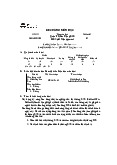



















Preview text:
This article was downloaded by: [New York University] On: 26 July 2015, At: 00:25 Publisher: Routledge
Informa Ltd Registered in England and Wales Registered Number:
1072954 Registered office: 5 Howick Place, London, SW1P 1WG International Journal of Electronic Commerce
Publication details, including instructions
for authors and subscription information:
http://www.tandfonline.com/loi/mjec20 A Study of the Value and Impact of B2B E- Commerce: The Case of Web-Based Procurement
Chandrasekar Subramaniam, Michael J. Shaw Published online: 23 Dec 2014.
To cite this article: Chandrasekar Subramaniam, Michael J. Shaw (2002) A
Study of the Value and Impact of B2B E-Commerce: The Case of Web-Based
Procurement, International Journal of Electronic Commerce, 6:4, 19-40
To link to this article: http://
dx.doi.org/10.1080/10864415.2002.11044245 PLEASE SCROLL DOWN FOR ARTICLE
Taylor & Francis makes every effort to ensure the accuracy of
all the information (the “Content”) contained in the publications
on our platform. However, Taylor & Francis, our agents, and our
licensors make no representations or warranties whatsoever as
to the accuracy, completeness, or suitability for any purpose of
the Content. Any opinions and views expressed in this publication
are the opinions and views of the authors, and are not the views
of or endorsed by Taylor & Francis. The accuracy of the Content
should not be relied upon and should be independently verified
with primary sources of information. Taylor and Francis shall not be
liable for any losses, actions, claims, proceedings, demands, costs,
expenses, damages, and other liabilities whatsoever or howsoever
caused arising directly or indirectly in connection with, in relation to
or arising out of the use of the Content.
This article may be used for research, teaching, and private
study purposes. Any substantial or systematic reproduction,
redistribution, reselling, loan, sub-licensing, systematic supply,
or distribution in any form to anyone is expressly forbidden.
Terms & Conditions of access and use can be found at http://
www.tandfonline.com/page/terms-and-conditions
ork University] at 00:25 26 July 2015 Y Downloaded by [New
A Study of the Value and Impact of B2B
E-Commerce: The Case of Web-Based Procurement
Chandrasekar Subramaniam and Michael J. Shaw
ABSTR AC T: Web-enabled business-to-business (B2B) e-commerce enhances
interorganizational coordination, resulting in transaction cost savings and competitive
sourcing opportunities for the buyer organization. However, organizations are uncertain
whether this is an improvement over existing information technology, such as EDI. In par-
ticular, what is the value of B2B e-commerce to a buyer organization, and how can it be
measured? What factors most affect the realization of the value of B2B e-commerce?
Using the case of Web-based B2B procurement systems, a framework is proposed to
quantify and measure the value of B2B e-commerce systems and identify the factors that
determine it. The methodology is applied to help a major heavy-equipment manufacturer
located in the midwestern United States evaluate the potential of its Web-based procure-
ment system. The preliminary results indicate that, even though all stages of B2B procure-
ment are affected by the Web, the value of Web-based procurement is most determined by
the process characteristics, organization of business units, and the “extended enterprise.”
KEY WORDS AND PHRASES: Extended enterprise, interorganizational information sys-
tems, value measurement, Web-based procurement.
Web-enabled applications for business-to-business (B2B) electronic commerce
are expected to enhance interorganizational coordination and improve rela-
tionships among business partners. Transaction cost savings and competitive
ork University] at 00:25 26 July 2015 Y
sourcing opportunities are the potential benefits of B2B procurement. How-
ever, organizations are still unsure whether a Web-based B2B e-commerce
system can deliver the promised benefits. For example, is the use of the Web
an improvement over existing, and mature, information technology (IT) sys-
tems, such as electronic data interchange (EDI)? Organizations need to mea-
sure and determine the impact of Web-based systems on B2B processes and
the value to the enterprise. Knowing the value of Web-based systems is a nec-
essary first step in motivating users to adopt one. Downloaded by [New
In the current economic environment, organizations are critically evalu-
ating their investments, and Web-based B2B systems are no exception. But
as IT has evolved from a productivity tool to a more pervasive and strategic
business tool, the measurement of its value to an organization has become
more challenging. Most evidence of Web benefits on the organizational level
is anecdotal, and there are very few systematic studies that look at the value
from an organization’s perspective. Moreover, the nature of the Web creates
impacts beyond traditional organizational boundaries, requiring the coop-
eration of business partners and, in some cases, even competitors within the
industry. A better framework is needed that can determine the value of the
Web for an organization and provide a clear understanding of what factors
affect this value. The objective of the research summarized in this article is
to fill this void by developing a comprehensive valuation framework for
B2B e-commerce that can be used to evaluate and formulate B2B implemen-
International Journal of Electronic Commerce / Summer 2002, Vol. 6, No. 4, pp. 19–40.
Copyright © 2002 M.E. Sharpe, Inc. All rights reserved. 1086-4415/2002 $9.50 + 0.00.
20 CHANDRASEKAR SUBRAMANIAM AND MICHAEL J. SHAW
tation strategies. Using Web-based B2B procurement as a case of B2B
e-commerce, this article presents a framework for determining the value of
Web-based systems and understanding how external and internal factors affect it.
Web-Based B2B Procurement Systems
A significant proportion of organizational resources is devoted to managing
interorganizational processes, such as procurement of goods and services from
other companies, collaboration for product development, and financial trans-
actions between companies. Procurement of goods and services, called busi-
ness-to-business procurement, involves the largest cost for an enterprise, with
many organizations spending 50 to 60 percent of their revenue on goods and
services [12]. Despite this, interorganizational information systems (IOS) and
other information technology applications have focused on more structured
processes, such as manufacturing, leaving most procurement processes ineffi-
cient and ineffective. Procurement usually covers two types of purchases—
direct and indirect. Direct purchases involve the raw materials and components
that go into the finished products sold to the customer. Indirect purchases, on
the other hand, involve goods and services that are not part of the finished
product but support internal business activities, such as computers, office
equipment, operating supplies, and office supplies.
The use of the Internet for procurement1 has generated great excitement
because of its potential to reduce procurement costs and improve strategic
sourcing [6, 16]. The availability of electronic markets and industry-specific
ork University] at 00:25 26 July 2015 Y
B2B exchanges has added to the choices available to organizations for manag-
ing their procurement [1]. From the point of view of B2B procurement, there
are four models of Web-based procurement systems (see Figure 1 ). These re-
flect the different ways that a buyer or a supplier can execute a B2B transac-
tion [13, 17, 22]. Each model creates value for buyers and sellers in unique
ways, and organizations typically use more than one of the models, if not all
of them. Table 1 summarizes the factors that create value and the factors that
affect value in each form of B2B procurement system. Downloaded by [New
Although researchers have predicted a significant shift toward electronic
market-based transactions [1, 18], every Web-based model has a different
way of creating value, and B2B managers have to evaluate the role of each
model in their enterprise. But it is clear that organizations, whether buyers
or sellers, can derive competitive advantage from any of these systems in
the form of economic benefits and increased business opportunities [9, 11,
29]. Interactions with the B2B managers of a large manufacturing organiza-
tion during the course of the research described here showed that there are
still doubts about the real benefits of the Web. Organizations that already
have an IOS of some kind, such as electronic data interchange, have not yet
decided whether the Web is an improvement over the existing system. More-
over, the different players in the B2B procurement process, such as users,
business units, central procurement managers, and suppliers, all have their
own, sometimes mutually conflicting, expectations from the system. As a 21 t n e m
ork University] at 00:25 26 July 2015 re Y cu ro P d se a -B b e f W o Downloaded by [New e lu a V e thr fo rk o w e m a . Fr 1 re u ig F
22 CHANDRASEKAR SUBRAMANIAM AND MICHAEL J. SHAW
Form of Web-based Factors that
Factors that affect procurement create value realized value Buy-side procurement system Reduced transaction costs Process characteristics Higher process qualit y Degree of centralization
Increased system responsiveness Degree of integration with Lower development costs enterprise systems Increased control Bargaining power of buyer Private B2B e-market Reduced product price Product characteristics Knowledge creation and Rate of innovation in industry dissemination Supplier fragmentation Lower search costs to locate Bargaining power of buyer sellers Industry B2B exchange Reduced product price Product characteristics
Increased utilization of surplus Size of industry assets Industry fragmentation Lower search costs to locate Power of buyers and sellers sellers or buyers Coordination among buyers Third-party B2B e-market Lower product price for buyers Industry fragmentation Lower search costs for buyers Liquidity and sellers Industry participation Service quality
Table 1. Value Created by Different Forms of Web-Based Procurement.
ork University] at 00:25 26 July 2015
result, the players may not all perceive the same value from implementing Y
a B2B system, and their perceptions are critical to successful adoption of the system [8].
To address these concerns in existing research and practice of B2B e-com-
merce, the following research questions were proposed:
1. What is the value of a B2B e-commerce system to an organization?
How can this value be measured? Downloaded by [New
2. What factors affect the value of a B2B e-commerce system?
3. What are the implications of the value for B2B implementation strategies?
These questions were addressed by studying the value of a Web-based pro-
curement system to a large buyer organization. The framework used for this
research identified three levels of factors—process, organization of business
units, and extended enterprise—and derived propositions on how these fac-
tors affect the value of Web-based procurement. Using preliminary data from
an organization, the framework was subjected to a limited empirical test with
the value as procurement cost savings and the effect of process-level charac-
teristics on this value. In future, the research will be extended to collect more
data for a comprehensive measurement of value and for empirical verifica-
tion of the complete framework, including the effect of organizational and
INTERNATIONAL JOURNAL OF ELECTRONIC COMMERCE 23
supply-chain characteristics. The analysis and empirical results summarized
below make it clear that B2B implementation is not a simple yes-or-no deci-
sion, but involves understanding the differences in the value of a B2B system
for various users and business units. The framework provides a roadmap for
successful implementation of B2B e-commerce systems.
A Review of Related Research
The impact of information technology on firm performance has long been a
subject of intensive research, with the issues studied ranging from measure-
ment of the impact to the conditions necessary to realize an impact. The real-
ized impact in the form of actual improvement in firm performance represents
the value of the IT system to the organization. However, researchers have
pointed out the conflicting results yielded by these studies [7, 10, 21, 25]. Some
of the issues relate to measurement, others to the complexity of isolating the
effect of IT on firm performance [21]. The problem of relating IT investments
to firm performance is complicated by the effect of confounding factors, such
as other internal performance-improvement measures and external economic
influences. Another issue is that some IT investments may provide benefits
after a certain period but increase operating costs in the short run [14]. Re-
searchers suggest a process-oriented approach to overcome these confound-
ing problems. Kauffman and Weill hold that the locus of impact, that is, the
business process, should be the primary level of value analysis for the ben-
efits to become discernible for the investing firm [15]. Barua et al. utilize a
multistage, process-oriented study to measure the first-order and higher-
ork University] at 00:25 26 July 2015 Y
order impact of IT [5]. Mukhopadhyay uses such an approach to under-
stand how EDI benefits an organization [19].
Research on the impact and value of interorganizational information sys-
tems, and particularly the use of electronic data exchange, has shown that
they are largely positive in improving the efficiency of business processes and
the overall performance of organizations [19, 26]. Electronic processing and
communication of interorganizational data improve the timeliness and accu-
racy of the information, allowing trading organizations to better plan and Downloaded by [New
manage their assets, such as inventory [4]. The use of IT improves the process
quality, which in turn improves the level of output [20]. Impacts of this type
occur mainly on the operational level and result in cost reduction, higher pro-
ductivity, and improved quality [19]. IOS also increases the bargaining power
of the buying organization, which now has a better information visibility of
its business processes [23, 24]. At the same time, however, by having access to
more information about the buyer, a supplier can better match the prefer-
ences of the buyer and extract a premium price. The close relationship built
up between buyer and supplier may also enable the supplier to gradually
increase its volume of business with the buyers.
These impacts, however, are neither guaranteed upon implementation of
the system nor uniform across the organization [5, 7, 19, 27]. Realization of the
value of the system is conditional upon internal and external factors, some of
which are controllable by the organization [27]. These are called conversion
24 CHANDRASEKAR SUBRAMANIAM AND MICHAEL J. SHAW
contingencies: “a spectrum of things that are likely to influence realized value
from a system” [7]. For example, the contribution of an IT system depends on
such resources as people and investments in associated processes [15]. In a
study of EDI impacts, Mukhopadhyay found that the operational benefits of
EDI increased with increased integration of the IOS with internal systems, but
decreased with more parts variety and a greater number of trading partners
[19]. Suppliers handling a larger proportion of their business electronically
saw better performance than other suppliers. With respect to strategic impact,
the size of the supplier determined what incentives were needed to join the
system. The strategic benefits were better if the buyer initiated the system or if
the system had been used for a longer time.
While some of the issues and critical variables of previous research are rel-
evant for Web-based systems, other issues and variables assume increased
importance. The capability of EDI to reduce communication and processing
costs and errors is also found in Web-based systems. But in Web-based sys-
tems, the potential to reduce search costs is great and affects every B2B trans-
action. Thus, in the present research, for example, savings in search cost
emerged as an important economic benefit. Coordination costs are reduced
significantly by using the Web, and the present research quantified the eco-
nomic impact of this reduction. The Web allows organizations to choose from
different procurement models, an issue that did not arise with EDI systems.
Many studies have looked at different pieces of the B2B puzzle, such as sup-
plier selection [3] and the impact of electronic markets [1, 9]. B2B e-com-
merce is rapidly transforming how organizations structure and coordinate
their business relationships, but there are very few systematic studies in this
area that try to understand the impacts comprehensively from an organiza-
ork University] at 00:25 26 July 2015 Y tional perspective.
Framework for Value of Web-Based Procurement
Our framework is based on a multistage impact model of information tech-
nology on enterprise processes [5, 10, 15, 19]. The principle is that certain fea-
tures or capabilities of the Web are used to enable B2B operations, which in Downloaded by [New
turn have an impact on a set of intermediate variables. The impact on inter-
mediate variables leads to improvements in performance. Any improvement
of a performance variable helps improve the effectiveness of the procure-
ment process, which is the B2B goal of the enterprise. The framework is shown in Figure 1.
Impact on B2B Tasks
A Web-based procurement system provides enhanced search capabilities, faster
and more accurate processing, real-time and rich-media information support,
and low communication and coordination costs [6, 16]. From the buying
enterprise’s point of view, the use of a Web-based system affects four major
categories of B2B operations: search, order processing, monitoring and con- trol, and coordination.
INTERNATIONAL JOURNAL OF ELECTRONIC COMMERCE 25 Search
Search costs are the costs incurred by a buyer in locating an appropriate seller
and purchasing a product [2]. In procurement, search costs are incurred when a
professional buyer looks for a supplier to contract purchases, and when an indi-
vidual user in an organization looks for an appropriate product to order. In
both cases, the Web and associated search engines considerably lower the search
costs, which can be quite significant in large organizations. Web-enabled search
engines help users to search using multiple methods to ensure that they can
find the right product even with limited available information. The system’s
“user-friendliness” reduces the “premium buys,” where the user goes around
the procurement system and incurs higher processing and product costs [12]. Processing
A Web-based procurement system involves electronic document routing and
information flow, thus reducing the labor costs entailed by manual process-
ing. A Web-based system can automatically route product requests for the
necessary approvals and order placements with suppliers. This reduces the
transaction cycle time and gets the materials to the user faster. As the system
requires only minimal data inputs during the information-processing cycle,
many former sources of error are eliminated. Thus, Web-based procurement
processing lessens cycle time, errors, and processing costs.
Monitoring and Control
ork University] at 00:25 26 July 2015 Y
Using a Web-based procurement system, organizations can achieve the twin
objectives of responding effectively to user needs and leveraging their com-
bined buying power. Users can search the catalog to identify the most cost-
effective supplier and place their orders. Corporate B2B managers can
aggregate the demand for a product so as to negotiate a more competitive
price, and then make the product available to the various business units of the
enterprise irrespective of their size or location. Centralized control, combined
with the availability of an increased range of items on the electronic catalog, Downloaded by [New
motivates more users to order through the e-procurement system, reducing
the number of premium buys. Thus, Web-based monitoring and control re-
duce both the average product price and the incidence of premium buys. Coordination
One of the major advances of a Web-based IOS over a traditional IOS is its
ability to support increased and more complex coordination. When fulfilling
an order, procurement personnel often need to communicate and exchange
information with suppliers and users. A Web-based procurement system pro-
vides a real-time information flow and is less costly to coordinate with suppli-
ers and users. This leads to faster resolution of problems and shortens order
cycle time. The low communication costs of the Web and the shorter time
26 CHANDRASEKAR SUBRAMANIAM AND MICHAEL J. SHAW
spent by the procurement staff for coordination result in lower transaction costs.
Impact on Performance Measures
The impact of the Web on B2B performance measures can be discussed in
terms of the concept of first-order and higher-order impacts suggested in the
literature on information technology [5, 15]. The first-order impact is on inter-
mediate measures closer to the process, which in turn affect performance
measures. One of the most visible performance impacts of Web-based pro-
curement is the lower total procurement cost. The reduction in transaction cycle
time resulting from the use of Web-based procurement reduces the labor time
used in the process and the labor cost component of the transaction costs.
Costs incurred due to electronic processing and coordination are several mag-
nitudes lower than those involved in manual processing and coordination.
The lower incidence of errors in a Web-based procurement system reduces
the need for labor for error resolution, thereby reducing transaction costs. With
less lead time for acquiring products, organizations can store less in inventory
and increase inventory turns, leading to lower inventory costs. The lower av-
erage prices negotiated for contracted items also contribute to the reduction in total procurement costs.
Quality of the Procurement Process
The quality of the procurement process is an indicator of how well a system
ork University] at 00:25 26 July 2015
meets the procurement needs of the enterprise. Any error in the processing Y
cycle decreases the chance that the product delivered to the user will fully
meet expectations. The proportion of B2B orders rejected or returned by the
user is a measure of process quality. So is the number of user complaints about
the product. By reducing the probability of errors, a Web-based system can
reduce the potential mismatch between user needs and the delivered prod-
uct, thus reducing user complaints. Downloaded by [New
User Satisfaction
User satisfaction refers to the perception of users that the system effectively meets
their business demands. This perception covers more than the receipt of a match-
ing product. User satisfaction is affected by how well the system is perceived to
meet user expectations. Higher cycle time and more errors in the process lead to
lower user satisfaction. Access to required information with minimum effort,
faster resolution of complaints, and ease of use of the system interface are some
ways in which user satisfaction can be improved by a Web-based system.
System Responsiveness
System responsiveness is the ability of a B2B procurement system to respond
to the needs of the user and the enterprise. It reflects not only the time taken to




